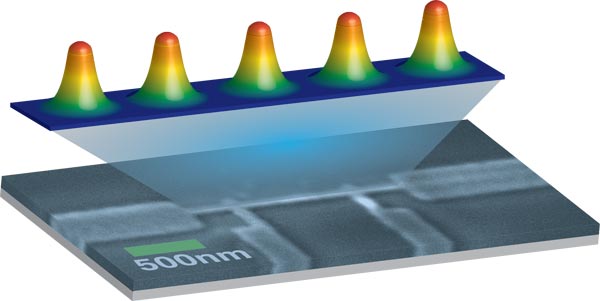Ultra-Thin Nanowires Can Trap Electron ‘Twisters’ That Disrupt Superconductors

Nina Markovic and Tyler Morgan-Wall/jhu This illustration depicts a short row of vortices held in place between the edges of a nanowire developed by Johns Hopkins scientists.
To keep supercurrents flowing at top speed, Johns Hopkins scientists have figured out how to constrain troublesome vortices by trapping them within extremely short, ultra-thin nanowires. Their discovery was reported Feb. 18 in the journal Physical Review Letters.
“We have found a way to control individual vortices to improve the performance of superconducting wires,” said Nina Markovic, an associate professor in the Department of Physics and Astronomy in the university’s Krieger School of Arts and Sciences.
Many materials can become superconducting when cooled to a temperature of nearly 460 below zero F, which is achieved by using liquid helium.
The new method of maintaining resistance-free current within these superconductors is important because these materials play a key role in devices such MRI medical scanners, particle accelerators, photon detectors and the radio frequency filters used in cell phone systems. In addition, superconductors are expected to become critical components in future quantum computers, which will be able to do more complex calculations than current machines.
Wider use of superconductors may hinge on stopping the nanoscopic mischief that electron vortices cause when they skitter from side to side across a conducting material, spoiling the zero-resistance current. The Johns Hopkins scientists say their nanowires keep this from happening.
Markovic, who supervised the development of these wires, said other researchers have tried to keep vortices from disrupting a supercurrent by “pinning” the twisters to impurities in the conducting material, which renders them unable to move.
“Edges can also pin the vortices, but it is more difficult to pin the vortices in the bulk middle area of the material, farther away from the edges,” she said. “To overcome this problem, we made a superconducting sample that consists mostly of edges: a very narrow aluminum nanowire.”
These nanowires, Markovic said, are flat strips about one-billionth as wide as a human hair and about 50 to 100 times longer than their width. Each nanowire forms a one-way highway that allows pairs of electrons to zip ahead at a supercurrent pace.
Vortices can form when a magnetic field is applied, but because of the material’s ultra-thin design, “only one short vortex row can fit within the nanowires,” Markovic said. “Because there is an edge on each side of them, the vortices are trapped in place and the supercurrent can just slip around them, maintaining the resistance-free speed.”
The ability to control the exact number of vortices in the nanowire may produce additional benefits, physics experts say. Future computers or other devices may someday use vortices instead of electrical charges to transmit information, they say.
The lead author of the Physical Review Letters article was Tyler Morgan-Wall, a doctoral student in Markovic’s lab. Along with Markovic, the co-authors were Benjamin Leith, who was an undergraduate at Johns Hopkins when the research took place; Nikolaus Hartman, a graduate student; and Atikur Rahman, who was a postdoctoral fellow in Markovic’s lab.
This research was support by National Science Foundation grants DMR-1106167 and PHYS-1066293. The Physical Review Letters journal article may be viewed at: http://journals.aps.org/prl/pdf/10.1103/PhysRevLett.114.077002
Color illustration and photographs available; contact Phil Sneiderman
Contact Information
Phil Sneiderman
Office: 443-997-9907/Cell: 410-299-7462
prs@jhu.edu / On Twitter: @filroy
Media Contact
All latest news from the category: Physics and Astronomy
This area deals with the fundamental laws and building blocks of nature and how they interact, the properties and the behavior of matter, and research into space and time and their structures.
innovations-report provides in-depth reports and articles on subjects such as astrophysics, laser technologies, nuclear, quantum, particle and solid-state physics, nanotechnologies, planetary research and findings (Mars, Venus) and developments related to the Hubble Telescope.
Newest articles

NASA: Mystery of life’s handedness deepens
The mystery of why life uses molecules with specific orientations has deepened with a NASA-funded discovery that RNA — a key molecule thought to have potentially held the instructions for…

What are the effects of historic lithium mining on water quality?
Study reveals low levels of common contaminants but high levels of other elements in waters associated with an abandoned lithium mine. Lithium ore and mining waste from a historic lithium…

Quantum-inspired design boosts efficiency of heat-to-electricity conversion
Rice engineers take unconventional route to improving thermophotovoltaic systems. Researchers at Rice University have found a new way to improve a key element of thermophotovoltaic (TPV) systems, which convert heat…



